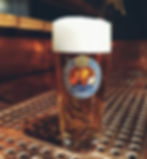Ancient Craft "Triple Decoction"
- Feb 8, 2022
- 3 min read
Updated: May 3, 2023
One very important ancient craft brewing method is Triple Decoction mashing. If you aren't sure what decoction mashing is, you'll want to read on.
First of all, what is mashing? Mashing is the stage of the brewing process where the malt grains are mixed with hot water to extract all the goodness from the barley. It's like making barley tea, but is far more complicated than making tea. At this key stage you need to make sure you end up with enough sugars for fermentation, proteins for body, and acids for flavor. Mashing is arguably the most important stage of the brewing process.
There are 3 ways to mash:
Infusion Mashing
Temperature-controlled (Step) Mashing
Decoction Mashing
Infusion means adding hot water to the malt. It's the simplest and most commonly used method. Temp-controlled means heating the whole mash tun up by direct heating. Since these two methods are quite modern, we are more interested in the traditional method: decoction.
Decoction in brewers' lingo means separating part of the mash, boiling that part, then returning it to the main batch. This action was very important to ancient brewers because, not having thermometers, they could use this foolproof method to achieve the right temperatures for mashing. Since the boiling temperature of water is a constant 212°F, when they combined a measured portion of boiling mash with the main portion of mash, they could be fairly accurate with target temperatures.
Furthermore, decoction mashing was necessary to increase fermentable sugar content when malts were under-modified, as malts usually were in ancient times. These under-modified malts meant that there were not enough soluble sugars and proteins for fermentation. Nowadays malts are usually highly-modified, making fermentation much simpler. In fact, a one temperature rest (single infusion) is usually sufficient.
Because decoction mashing is not strictly necessary anymore, very few brewers use it except for traditional German breweries like Göller. However, this old style decoction method remains important. It imparts a special flavor that is found in craft German beer – a robust maltiness that can't be replicated by step or infusion mashing.
What exactly is the science behind this claim?

The Basics of Mashing
Basically mashing-in the malt further breaks down the barley into the right elements for fermentation by using the naturally occurring enzymes. Malt contains enzymes that are needed to turn starches into maltose, a sugar needed for fermentation. There are three types of enzymes that do the job, but each type gets activated at a different temperature. There are also important acids that get released at the lower temperatures.
In a Step or Decoction mashing, the mash is allowed to rest at four different temperatures of roughly 95°F, 127°F, 150°F, and 160°F. These are the temperatures at which specific acids & enzymes are activated. Depending on your preferred flavor profile, you can choose which rests you want.
The first rest temperature of 95°F is usually reached by a simple infusion of hot water, but the next three rests were done by triple decoction. Ancient brewers discovered that by removing 1/3 of the liquid mash, boiling it, then adding it back into the mash, they could bring the mash to these three stages as needed. They didn't know what was happening scientifically, but they knew it worked.
Here is a sketch of the resting stages.
95F (35C) – Acid and Glucanese Rest
127F (52C) – Protein Rest
145F-153F (63-67C) – Beta Amalyse Rest
158-167F (72-75C) – Alpha Amalyse Rest
Of course, these steps can be achieved nowadays by temperature-controlled, step mashing. Rather than decoct, brewers simply raise the temperature 4 times to the desired stages. It's so much easier with thermometers!
But is anything lost when you do not decoct? German craft brewers say "yes." Different things happen when you boil and re-add it to the mash, such as increased Maillard Reactions that add maltier flavors to the beer. There is a lot of debate over this topic in the brewer's world, but Göller Brewery believes that they make a better beer by using the traditional method.
The key distinction is that decoction means bringing a part of the mash to boiling, whereas temp-controlled, step mashing involves no boiling. What's the difference?
Here are some advantages to boiling part of the mash.
Boiling extracts much more flavor from the malt.
Boiling the mash breaks down the grain cell walls, resulting in higher extraction rates of the fermentable sugars.
Boiling wort will caramelize a portion of it, enhancing the malty character of the beer.
Proteins in the mash tend to coagulate during the boil and so result in clearer, more transparent beer.

To sum it up, there are basically three ways to do mashing, but using the ancient craft Triple Decoction method results in the richest flavor profiles. This is why Göller Brewery continues to do all the extra labor required for decoction. They try to make the finest beer on the planet, not just do the bare minimum.
